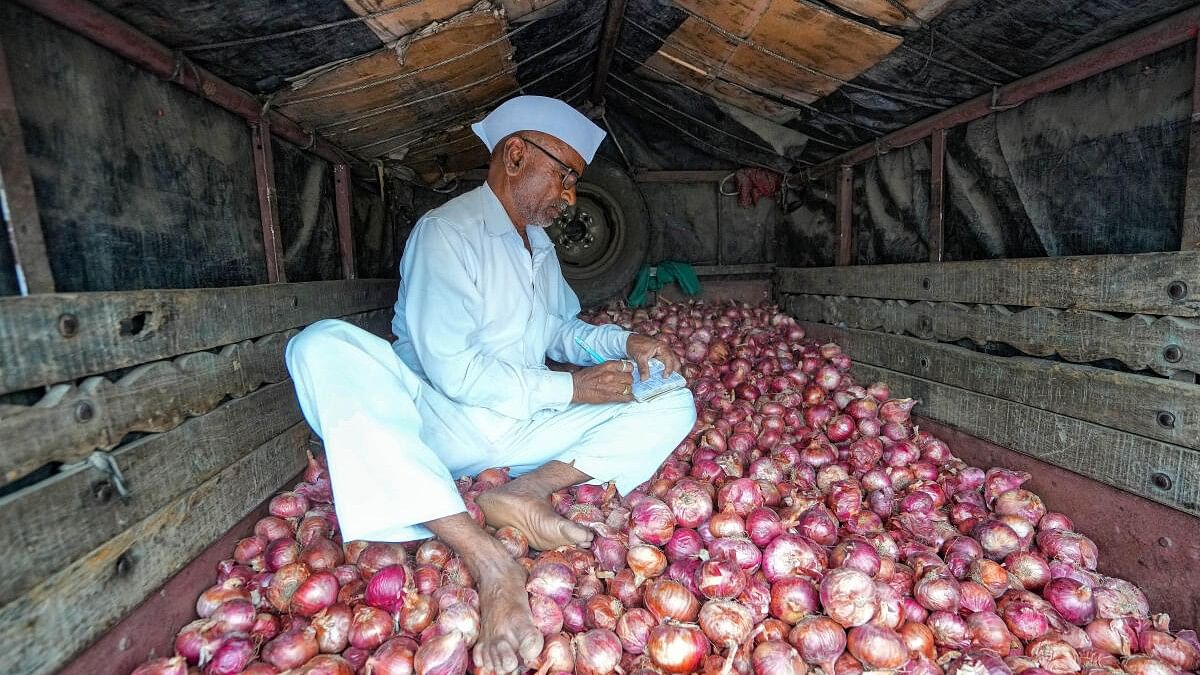
A farmer at Vinchur onion market in Nashik.
Credit:PTI
A month ago, the Government of India imposed a 40% export duty, announced offloading of existing onion stocks at subsidised rates, and initiated the procurement of stocks from farmers. These steps aimed to bolster the supply in the domestic market and reign in a sharp increase in tomato (650%) and subsequently onion (25%) in retail prices on a year-on-year basis. This move has created a furore in the onion markets, leading to indefinite closed auctions by farmers and trade associations in Maharashtra’s onion wholesale markets. The question arises: What prompted the government interventions, and what impact do they have on prices, demand, and supply in domestic markets? Why is it particularly hurting farmers and traders? Could India suffer setbacks in the global market?
Fluctuations in onion prices are typically a seasonal phenomenon, with prices tending to be higher from July to November due to the dwindling Rabi supply, generally harvested from March to May. However, the recent spike in onion prices has much to do with a series of climatic events, a surge in food prices, and an increase in the overall cost of living. Depressed prices since mid-2022 led to a decline in Rabi season sowing. Unseasonal rainfall during harvesting, higher temperatures in February, delayed and deficient rainfall by 41% to 92%, and increased onion exports contributed to the rising prices and speculative activities by market intermediaries. The discontent among consumers over higher food inflation prompted the government to impose a 40% duty on onion exports, announce the upload of existing stock at a subsidised rate of Rs 25/kg, and increase stock from 3 lakh to 5 lakh tonnes as a part of the market stabilisation programme. The unintended consequences of these measures were a gradual decline in the domestic wholesale prices from Rs 4000-5000/quintal to Rs 600 to 2400/quintal during the last month.
While these interventions proved effective in the short term, they have made the political situation sensitive in Maharashtra. The imposition of export duty and offloading stocks at subsidised rates in retail markets have deprived farmers of better income, exacerbating their struggles with low prices, harvest and post-harvest losses, and increasing cultivation costs. Simultaneously, it sends a message of policy bias and mocks the government’s advocacy to deregulate agricultural markets through Farm Bills 2020. These measures have also impacted the profit margins of market intermediaries and incentives to participate in auctions in APMC yards. Despite repeated meetings, the deadlock between farmers, traders’ associations, the Maharashtra state, and the central government remains unresolved even after a month.
The use of trade policy interventions in agricultural trade to manage prices of onion, tomato, and non-Basmati rice in the domestic market undermines the interests of farmers and the rules of the World Trade Organisation (WTO). These rules mandate (under Art VIII (1)) that all fees and charges imposed by contracting parties on importation or exportation should be limited to the approximate cost of services rendered. This move also contradicts the declaration passed by G-20 members on September 9, 2023, stating that “G-20 will also facilitate open, fair, predictable, and rule-based agriculture, food, and fertiliser trade, not impose export prohibitions or restrictions, and reduce market distortions in accordance with relevant WTO rules”. These interventions also hurt India’s standing as a reliable trade partner in global trade. The US and Japan have earlier dragged India to the WTO over frequent bans imposed on onions, and the imposition of an export duty on onions may attract another WTO dispute against India.
India’s top export destinations are usually Malaysia, the UAE, Sri Lanka, Indonesia, Saudi Arabia, Bangladesh, Kuwait, Germany, and the UK. India exports above $300 million worth of onion and over 12% of world trade. The fastest-growing onion exporters recently were Egypt (up 53.5%), Canada (up 49.4%), Poland (up 47.4%), and Afghanistan (up 45%). Conversely, countries experiencing declines were Pakistan (-68.9%), New Zealand (-27.4%), and France (-17.5%). Will India join the second group, besides dampening our onion trade in the world market? The answers to these certainly rest with our policymakers and the responses of the exporters. Currently, the policy disturbs the trade link between exporters and APMC wholesaler traders and imposes a heavier burden on wholesalers and exporters than on farmers. Short-term (mis-)management will hurt the incentives of farmers, traders, and exporters in the short term and consumers in the medium term.
Amid the growing income disparities between farm and non-farm households and various interventions by the states towards doubling farm income, the policy certainly exposes the double standard of the government and the outcry for fairness from farmers and traders participating in the supply chain in the export of these commodities. The government interventions may only prove to be temporary relief for consumers unless rain-deficient onion-growing regions receive enough rainfall in the remaining period of the monsoon and how quickly the non-participation of traders and farmers in major onion market APMCs of Maharashtra is resolved. Given the upcoming elections both in the state and Union, issues are likely to be resolved soon. However, for better management of onion prices, the government will have to rely on crop management in traditional and non-traditional supply zones to cover the expected deficit in production and take action on artificial hoardings without hurting the interests of farmers or undermining its position as a reliable trade partner in international trade.
(The writer is a researcher at the Institute for Social and Economic Change)